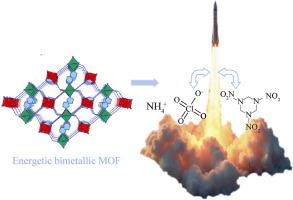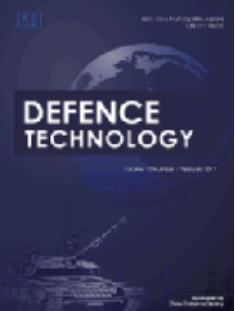Bimetallic MOF (Mn/Co) constructed by active dicyandiamide linker for a promising combustion catalyst of solid propellant
IF 5.9
Q1 ENGINEERING, MULTIDISCIPLINARY
引用次数: 0
Abstract
Combustion catalyst is a key modifier for the performance of composite solid propellant. To exploit high-efficiency combustion catalyst, a fascinating bimetallic metal-organic framework [MnCo(EIM)2(DCA)2]n (1) was constructed by an active dicyandiamide (DCA) linker, Mn2+, Co2+ centers, and an 1-ethylimidazole (EIM) ligand. 1 possesses good thermal stability (Tp = 205 °C), high energy density (Eg = 24.34 kJ/g, Ev = 35.93 kJ/cm3), and insensitivity to impact and frictional stimulus. The catalytic effects of 1 contrasted to monometallic coordination compounds Mn(EIM)4(DCA)2 (2) and Co(EIM)4(DCA)2 (3) on the thermal decomposition of AP/RDX composite were investigated by a DSC method. The decomposition peak temperatures of AP and RDX of the composite decreased to 335.8 °C and 206.4 °C, respectively, and the corresponding activation energy decreased by 27.3% and 43.6%, respectively, which are better than the performances of monometallic complexes 2 and 3. The gas products in the whole thermal decomposition stage of the sample were measured by TG-MS and TG-IR, and the catalytic mechanism of 1 to AP/RDX was further analyzed. This work reveal potential application of bimetallic MOFs in the composite solid propellants.

活性双氰胺连接剂构建的双金属MOF (Mn/Co)是一种很有前途的固体推进剂燃烧催化剂
燃烧催化剂是影响复合固体推进剂性能的关键改性剂。为了开发高效的燃烧催化剂,以活性双氰胺(DCA)连接剂、Mn2+、Co2+中心和1-乙基咪唑(EIM)配体为原料,构建了一种令人瞩目的双金属金属有机骨架[MnCo(EIM)2(DCA)2]n(1)。1热稳定性好(Tp = 205℃),能量密度高(Eg = 24.34 kJ/g, Ev = 35.93 kJ/cm3),对冲击和摩擦刺激不敏感。采用DSC法考察了1与单金属配位化合物Mn(EIM)4(DCA)2(2)和Co(EIM)4(DCA)2(3)对AP/RDX复合材料热分解的催化作用。复合材料AP和RDX的分解峰温度分别降至335.8℃和206.4℃,对应的活化能分别下降27.3%和43.6%,性能优于单金属配合物2和3。采用TG-MS和TG-IR对样品整个热分解阶段的气体产物进行了测定,并进一步分析了1对AP/RDX的催化机理。本工作揭示了双金属MOFs在复合固体推进剂中的潜在应用。
本文章由计算机程序翻译,如有差异,请以英文原文为准。
求助全文
约1分钟内获得全文
求助全文
来源期刊

Defence Technology(防务技术)
Mechanical Engineering, Control and Systems Engineering, Industrial and Manufacturing Engineering
CiteScore
8.70
自引率
0.00%
发文量
728
审稿时长
25 days
期刊介绍:
Defence Technology, a peer reviewed journal, is published monthly and aims to become the best international academic exchange platform for the research related to defence technology. It publishes original research papers having direct bearing on defence, with a balanced coverage on analytical, experimental, numerical simulation and applied investigations. It covers various disciplines of science, technology and engineering.
 求助内容:
求助内容: 应助结果提醒方式:
应助结果提醒方式:


